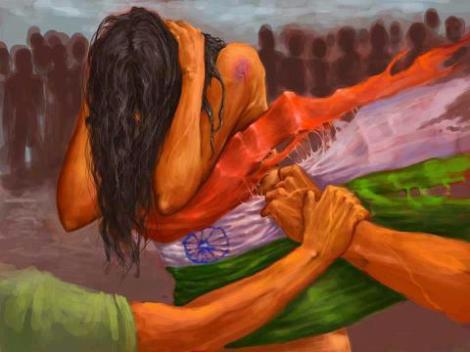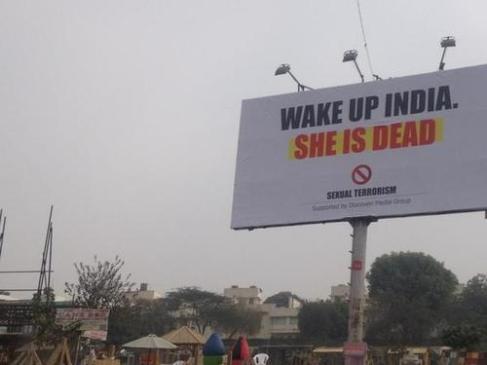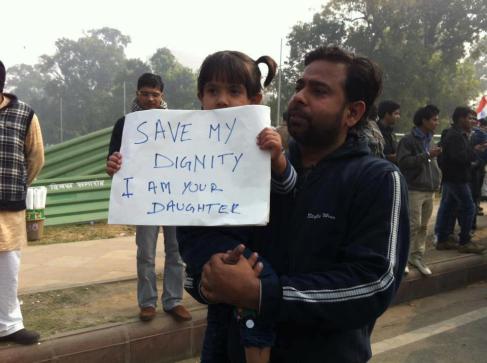Ever since I was in the 5th grade and read the fictional book Shiva’s Fire, I became obsessed with Indian culture. The music, the food, the vibrant colors and beautiful people, I couldn’t get enough. Now, at 22 years old, I will finally be traveling there in Fall.
India has only served as a source of amazement and beauty for me, but as I was sitting on my couch with my family watching the PBS NewsHour this past Winter break, I witnessed a dark side of Indian culture.
On December 16th, 2012, a 23-year-old female medical student was brutally gang raped by six men on a moving bus. They beat her with iron rods and each took their turn, forcing themselves upon her, as the driver continued to drive the charter bus. However, the driver of the bus did take a break, to ensure that he, of course, got his own turn in raping the girl. The girl and her male friend who was accompanying her were thrown out of the bus, stripped of all their clothes, and lying on the side of the road. The girl’s stomach was torn open from the beatings with the iron rods and her intestines were coming out of her body. She was in such a critical condition that she could not be treated at any local hospital and was transported to Mount Elizabeth Hospital in Singapore. The girl could not recover from her severe injuries and died within the week.
After seeing the news coverage, I was horrified. Though I am not a big social media subscriber, I flocked to Tumblr to see if many other Americans knew about this yet. And to my amazement, my home “dashboard” was already covered with pictures of angry protesters and candlelight vigils, and poems and enraged rants written by the people I am ‘following,’ most of whom are living in the U.S. The news story had just aired that night, so I was shocked about how many people were already posting their responses. Here are a few haunting photos that have been heavily circulated on Tumblr surrounding the rape:




In Delhi alone, there were 572 reported rapes last year, and 635 cases this year so far. The fact that these numbers are so shockingly high in the capital of India, it is scary to imagine what these numbers look like in more remote, rural areas, where there is less policing and, more likely, higher numbers of cases that go unreported.
But obviously, with these appalling statistics, there must be something deeper at the source of all these rapes; some sort of inapt mentality rooted within the culture. There is no way that the 635 Delhi women just happened to all be “at the wrong place, at the wrong time” this year.
In a New York Times article that was released just one day after the attack, the journalist quoted a man named Ram Singh while he was waiting at a bus stop in Delhi. “It’s the girl’s weakness in most cases,” claimed Singh. “They become friends and then they fight. Sudden, unknown attacks are usually a minority of the cases. In most cases, it’s the girl’s fault.” The irony of this article’s quote source, is that this very man (Ram Singh) was later convicted as the ringleader of the gang rape. He was found dead in his jail cell before he could receive his sentence.
New York Times Article
However, Indian men’s mentalities are not the sole culprit here. Shortly after this attack, there were many conferences held (mainly by educators and scholars) to discuss why violence towards women is such a recurring issue in India. One of the women who spoke at a seminar regarding “Women’s Empowerment,” Dr. Anita Shukla, received a lot of flack for her speech. “Had the girl simply surrendered (and not resisted) when surrounded by six men, she would not have lost her intestine. Why was she out with her boyfriend at 10 pm?” Shukla followed up by stating, “When a group of men intend to rape, they will do it. The victim should save herself for bringing the perpetrators to book.”
Dr. Anita Shukla’s Quote Regarding the Attack
By comparing the New York Times’ coverage of this incident to that of The Hindu’s (a very popular and reputable news source in India), it is very clear that even India’s media info is distributed through a tailored lens.
Within the second sentence of the debut article regarding the attack, The Hindu’s authors are careful to mention the male friend that was with the girl. They highlight his injuries as well, making him just as much of a focal point as the girl.
“The girl’s male friend was also assaulted, stripped and then thrown off of the bus along with her near the Mahipalpur flyover in south-west Delhi.”
The Hindu
The article also gave the impression that the passersby were eager to help, “Shocked and numbed, the victims were barely able to raise an alarm when they were spotted by a security guard deployed at a nearby construction site, who immediately called up the police suspecting that something was amiss as the two had sustained injuries and were bleeding.” However, a video was released of an interview with the male friend, and he describes his account in a different light:
VIDEO
With protests still occurring every day in Delhi, women are begging government officials to take a stand. While some ask for the death penalty for the perpetrators, most are calling for education programs, teaching boys to treat women with respect. While these requests have gone unanswered, the government has proposed to conduct nightly police patrols and ban buses from having curtains or window tints. For the country famously referred to as the “Largest Democracy,” in my opinion, this is a sad-excuse for listening to its citizens and “taking action.”
In order for the numbers of rapes to decrease, India’s men will first need to learn humanity. Women’s picket signs ask, “Where’s our India?” And the answer to that question will sadly take a relearning and re-teaching of an entire country’s culture.





